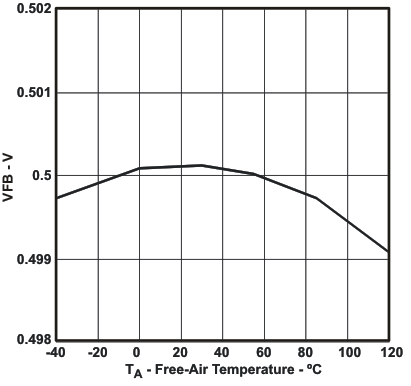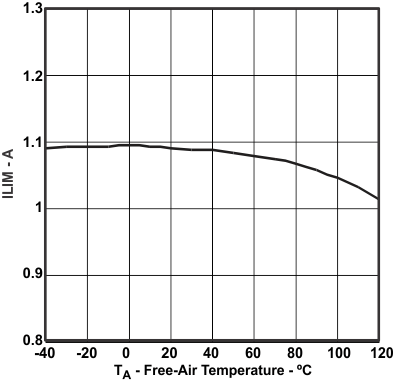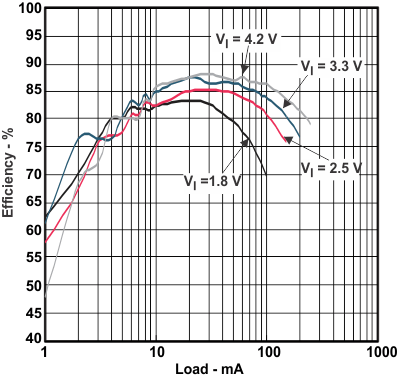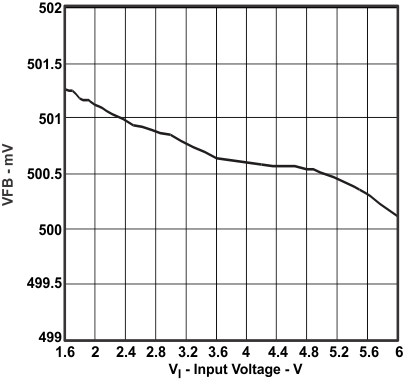ZHCSDB3 January 2015 TPS61093-Q1
PRODUCTION DATA.
- 1 特性
- 2 应用
- 3 说明
- 4 简化电路原理图
- 5 修订历史记录
- 6 Pin Configuration and Functions
- 7 Specifications
- 8 Detailed Description
- 9 Application and Implementation
- 10Power Supply Recommendations
- 11Layout
- 12器件和文档支持
- 13机械封装和可订购信息
7 Specifications
7.1 Absolute Maximum Ratings
over operating free-air temperature range (unless otherwise noted)(1)| MIN | MAX | UNIT | ||
|---|---|---|---|---|
| Supply voltage on pin VIN(2) | –0.3 | 7 | V | |
| Voltage on pins CP2, EN, and SS(2) | –0.3 | 7 | V | |
| Voltage on pin CP1 and FB(2) | –0.3 | 3 | V | |
| Voltage on pin SW, VO, and OUT(2) | –0.3 | 20 | V | |
| Operating Junction Temperature Range | -40 | 150 | °C | |
| Tstg, Storage temperature range | -55 | 150 | °C | |
(1) Stresses beyond those listed under Absolute Maximum Ratings may cause permanent damage to the device. These are stress ratings only and functional operation of the device at these or any other conditions beyond those indicated under Recommended Operating Conditions is not implied. Exposure to absolute-maximum-rated conditions for extended periods may affect device reliability.
(2) All voltage values are with respect to network ground terminal.
7.2 ESD Ratings
| VALUE | UNIT | |||||
|---|---|---|---|---|---|---|
| V(ESD) | Electrostatic discharge | Human body model (HBM), per AEC Q100-002(1) | ±2000 | V | ||
| Charged device model (CDM), per AEC Q100-011 |
Corner pins (1, 5, 6, and 10) | ±750 | ||||
| Other pins | ±500 | |||||
(1) AEC Q100-002 indicates HBM stressing is done in accordance with the ANSI/ESDA/JEDEC JS-001 specification.
7.3 Recommended Operating Conditions
over operating free-air temperature range (unless otherwise noted)| MIN | NOM | MAX | UNIT | ||
|---|---|---|---|---|---|
| Vi | Input voltage range | 1.6 | 6 | V | |
| Vo | Output voltage range at VO pin | 17 | V | ||
| L | Inductor(1) | 2.2 | 4.7 | 10 | μH |
| Cin | Input capacitor | 4.7 | μF | ||
| Co | Output capacitor at OUT pin(1) | 1 | 10 | μF | |
| Cfly | Flying capacitor at CP1 and CP2 pins | 10 | nF | ||
| TJ | Operating junction temperature | –40 | 125 | °C | |
| TA | Operating ambient temperature | –40 | 125 | °C |
(1) These values are recommended values that have been successfully tested in several applications. Other values may be acceptable in other applications but should be fully tested by the user.
7.4 Thermal Information
| THERMAL METRIC(1) | TPS60193-Q1 | UNIT | |
|---|---|---|---|
| DSK | |||
| 10 PINS | |||
| RθJA | Junction-to-ambient thermal resistance | 49.2 | °C/W |
| RθJC(top) | Junction-to-case (top) thermal resistance | 63.3 | |
| RθJB | Junction-to-board thermal resistance | 23.4 | |
| ψJT | Junction-to-top characterization parameter | 1.1 | |
| ψJB | Junction-to-board characterization parameter | 23.0 | |
| RθJC(bot) | Junction-to-case (bottom) thermal resistance | 5.7 | |
(1) For more information about traditional and new thermal metrics, see the IC Package Thermal Metrics application report, SPRA953.
7.5 Electrical Characteristics
VIN = 3.6 V, EN = VIN, TA = TJ = –40°C to 125°C, typical values are at TA = 25°C (unless otherwise noted)| PARAMETER | TEST CONDITIONS | MIN | TYP | MAX | UNIT | |
|---|---|---|---|---|---|---|
| SUPPLY CURRENT | ||||||
| VIN | Input voltage range, VIN | 1.6 | 6 | V | ||
| IQ | Operating quiescent current into VIN | Device PWM switching no load | 0.9 | 1.5 | mA | |
| ISD | Shutdown current | EN = GND, VIN = 6 V | 5 | μA | ||
| UVLO | Undervoltage lockout threshold | VIN falling | 1.5 | 1.55 | V | |
| Vhys | Undervoltage lockout hysterisis | 50 | mV | |||
| ENABLE AND PWM CONTROL | ||||||
| VENH | EN logic high voltage | VIN = 1.6 V to 6 V | 1.2 | V | ||
| VENL | EN logic low voltage | VIN = 1.6 V to 6 V | 0.3 | V | ||
| REN | EN pull down resistor | 400 | 800 | 1600 | kΩ | |
| VOLTAGE CONTROL | ||||||
| VREF | Voltage feedback regulation voltage | 0.49 | 0.5 | 0.51 | V | |
| IFB | Voltage feedback input bias current | 100 | nA | |||
| fS | Oscillator frequency | 1.0 | 1.2 | 1.4 | MHz | |
| Dmax | Maximum duty cycle | VFB = 0.1 V | 90% | 93% | ||
| POWER SWITCH, ISOLATION FET | ||||||
| RDS(ON)N | N-channel MOSFET on-resistance | VIN = 3 V | 0.25 | 0.4 | Ω | |
| RDS(ON)iso | Isolation FET on-resistance | VO = 5 V | 2.5 | 4 | Ω | |
| VO = 3.5 V | 4.5 | |||||
| ILN_N | N-channel leakage current | VDS = 20 V | 3 | μA | ||
| ILN_iso | Isolation FET leakage current | VDS = 20 V | 1 | μA | ||
| VF | Power diode forward voltage | Current = 500 mA | 0.8 | V | ||
| OC, ILIM, OVP SC AND SS | ||||||
| ILIM | N-Channel MOSFET current limit | 0.9 | 1.1 | 1.6 | A | |
| Vovp | Over voltage protection threshold | Measured on the VO pin | 18 | 19 | V | |
| Vovp_hys | Over voltage protection hysteresis | 0.6 | V | |||
| IOL | Over load protection | 200 | 300 | mA | ||
| THERMAL SHUTDOWN | ||||||
| Tshutdown | Thermal shutdown threshold | 150 | °C | |||
| Thysteresis | Thermal shutdown hysteresis | 15 | °C | |||
7.6 Timing Requirements
VIN = 3.6 V, EN = VIN, TA = TJ = –40°C to 125°C, typical values are at TA = 25°C (unless otherwise noted)| PARAMETER | TEST CONDITIONS | MIN | TYP | MAX | UNIT | |
|---|---|---|---|---|---|---|
| Toff | EN pulse width to shutdown | EN high to low | 1 | ms | ||
| Tmin_on | Minimum on pulse width | 65 | ns | |||
7.7 Typical Characteristics
Table 1. Table Of Graphs
| Figure 1, L = TOKO #A915_Y-100M, unless otherwise noted | FIGURE | ||
|---|---|---|---|
| η | Efficiency | vs Load current at OUT = 15 V | Figure 1 |
| η | Efficiency | vs Load current at OUT = 10 V | Figure 2 |
| VFB | FB voltage | vs Free-air temperature | Figure 3 |
| VFB | FB voltage | vs Input voltage | Figure 4 |
| ILIM | Switch current limit | vs Free-air temperature | Figure 5 |
| Line transient response | VIN = 3.3 V to 3.6 V; Load = 50 mA | Figure 10 | |
| Load transient response | VIN = 2.5 V; Load = 10 mA to 50 mA; Cff = 100 pF | Figure 11 | |
| PWM control in CCM | VIN = 3.6 V; Load = 50 mA | Figure 12 | |
| PWM control in DCM | VIN = 3.6 V; Load = 1 mA | Figure 13 | |
| Pulse skip mode | VIN = 4.5 V; OUT = 10 V; No load | Figure 14 | |
| Soft start-up | VIN = 3.6 V; Load = 50 mA | Figure 15 | |

| OUT = 15V |
 Figure 3. FB Voltage vs. Free-Air Temperature
Figure 3. FB Voltage vs. Free-Air Temperature
 Figure 5. Switch Current Limit vs. Free-Air Temperature
Figure 5. Switch Current Limit vs. Free-Air Temperature

| OUT = 10V |
 Figure 4. FB Voltage vs. Input Voltage
Figure 4. FB Voltage vs. Input Voltage